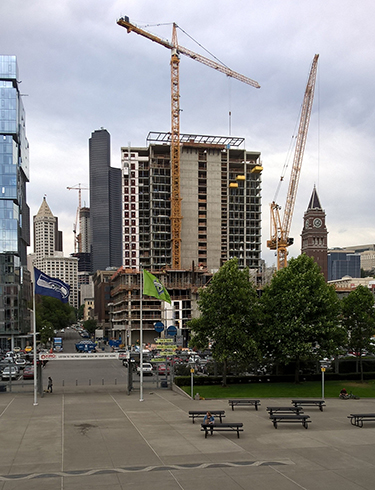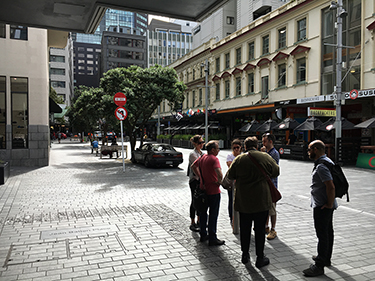|
Subscribe / Renew |
|
|
Contact Us |
|
| ► Subscribe to our Free Weekly Newsletter | |
| home | Welcome, sign in or click here to subscribe. | login |
Architecture & Engineering
| |

|
|
Design Perspectives By Clair Enlow |
March 22, 2017
Design Perspectives: Can we get ahead of the cranes with an urban design plan?
Special to the Journal
Last month, 1,200 people attended Downtown Seattle Association's annual State of Downtown event, and learned there are now 68 construction sites in the city. Most of these are towers, literally changing the city's skyline as they top out.
Instead of leveling off, Seattle's boom seems to be charging ahead.
But which of these projects will make Seattle a better place, and which will just crowd out views and clutter up streets? What is it going to be like to move among them?
And what, exactly, does the city of Seattle have to do with this?
Not enough, according to some architects, who point to other cities like Auckland, New Zealand, as examples of a different approach. They want our town to look harder at its future, from the streets to the tower tops — and even to a possible lid over the freeway.
Why not? Wouldn't it be great if the city's ambitions finally got ahead of its surges, instead of trailing behind — leaving the sidewalks to developers and important permitting decisions to overworked review boards?
Urban designer Dennis Haskell thinks so. He's calling for an urban design framework plan for downtown Seattle, and is working through a committee at the American Institute of Architects Seattle chapter (AIA Seattle) to look at what such a plan should include.
As a former chair of the Seattle Design Commission, Haskell has seen too many short-term fixes for urgent problems. What he wants is a guide for reviews and permitting for downtown projects, one that is more ambitious, comprehensive and three-dimensional than what we have now — from street to skyline.
Haskell and others with AIA Seattle are working on a “position paper” with more details, but it might show how to make sure towers are adequately spaced from their neighbors, or how best to break up full-block projects and invite pedestrians to pass through.
Not just more guidelines
It might touch on land use — from the location of a downtown school to how a lid over the freeway could be used — as well as transportation infrastructure. It would not be just another set of guidelines or standards similar to the ones that govern design review in neighborhoods throughout Seattle.
Urban designer Lee Copeland, who is on the Seattle Design Commission and active in AIA Seattle, would also like to see a more comprehensive plan for downtown. When you look at things incrementally, Copeland says, you miss the ways they connect.
A far-reaching plan could not only spur better design, it could give volunteer review boards — like the Seattle Design Commission (which vets projects in the public realm) and the Downtown Design Review Board (which guides private projects) — more to go on.
It's a tall order, and the city is starting at the ground. One Center City is a framework plan for the public realm — mostly streets — in downtown Seattle. In about a year, elements of this plan are expected to go before Seattle City Council for approval. King County Metro also is involved in the effort.
Now based with the Seattle Department of Transportation, One Center City began with the immediate goal of dealing with buses that will have to vacate the tunnel they now share with light rail when Convention Center Station closes next year. (If you're wondering, more buses will go onto downtown streets, and some lines will begin terminating near light rail at the International District Station and the University of Washington Station.)
After that, the Seattle Office of Planning and Community Development will be getting more involved, looking at strategies for making downtown streets more pleasant and useful for pedestrians and bicyclists.
It may not go far enough, but Gary Johnson and Lyle Bicknell of Planning & Community Development are quick to point out that One Center City is not just about traffic lanes and sidewalks. It's about the experience of moving through downtown streets. That includes things like storefronts and the designation of corridors like Pike-Pine for special treatment. Pike-Pine will connect Capitol Hill with the redeveloping waterfront.
If that seems ambitious, take a look at Auckland.
Architect Rick Mohler teaches urban design at the University of Washington College of Built Environments, and also co-chairs the Public Policy Board of AIA Seattle. With a group sponsored by the UW's Runstad Center for Real Estate Studies, Mohler traveled to Auckland last spring to see how they do planning and development in that city, which has some similarities to Seattle. You can see a presentation about this at https://vimeo.com/187929477.
The group chose to study Auckland because of the similarities with Seattle, such as topography, water, age, size, and disparities between rich and poor.
Thinking big
But Mohler said the differences between the two cities soon became apparent to the Runstad group. First, Aucklanders love urban design. Champions for visionary planning within the city last through multiple administrations, and they have big staffs.
The streets have evolved. Take sidewalks for an example. Auckland used to leave sidewalk construction to private developers — just like Seattle. They ended up with disjointed sidewalks — just like Seattle. But Auckland changed the law, so that the city now designs and builds sidewalks, and developers pay through an assessment, not a construction line item.
The result has been so successful that Mohler said private developers have been known to duplicate public sidewalk paving in their ground-floor private spaces.
Auckland has a tradition of commonwealth-style, top-down planning. Seattle has — well, the Seattle Process — a tradition of bottom-up planning and obstructive attitudes, all coupled with suspicion of government and plain old self-interest. It's hard to get things done here.
Our emissaries to Auckland saw that a real vision links existing assets with big dreams in a systemic way. It's part of the story of the city.
Seattle planners may never get as much love as their counterparts in New Zealand, but they should be able to think big and get respect.
One Center City is likely to help make Seattle streets truly multi-modal and more pleasant for walking. This is unlikely to satisfy advocates with AIA Seattle, who want city planners to revisit more aspects of downtown development — from height to land use — even while the boom is on.
This cry for more control has an echo: It happens with every spike in construction. Planning is always too little, too late.
But this boom is different. Unlike other neighborhoods, downtown Seattle has the advantage of a private partner in the Downtown Seattle Association, which has recently stepped up to invest in programming for open spaces and promoting corridor studies like Pike-Pine Renaissance. The DSA is putting its civic muscle behind the One Center City process.
DSA President Jon Scholes expects we'll see a lot more people in downtown Seattle. “We have to get ahead of the future growth downtown,” he said.
He likes the focus on pedestrians in One Center City, and seems to have reservations about expanding the scope of the plan to include things like tower spacing and school location. “We can't do it all,” he said.
On the other hand, Scholes thinks big initiatives like a partial lid over I-5 should be “part of the conversation.”
Now that more Seattleites walk, bike or take transit to get around, the city's streets, sidewalks and even parks are getting more of the respect they deserve. Maybe the city can raise its sights to a larger vision before the next boom.
Clair Enlow can be reached by e-mail at clair@clairenlow.com.
Previous columns:
- Design Perspectives: Would a ‘pause’ hurt SAAM’s expansion project?, 02-08-2017
- Design Perspectives: A walk in Santiago offers lessons for other cities, 01-11-2017
- Design Perspectives: Affordable housing is getting bigger and better, 11-30-2016
- Design Perspectives: ST3: Even at $54B, it's the only way to grow, 11-02-2016
- Design Perspectives: A path of great resistance in Steinbrueck Park, 10-12-2016
- Design Perspectives: Townhouses adding density to neighborhoods, 09-14-2016
- Design Perspectives: The future looks bright for Seattle's waterfront, 08-10-2016
- Design Perspectives: Occidental Park getting a great new neighbor, 07-27-2016




